Ancient City of Polonnaruwa
By Ersilia Octave
What is the Ancient City of Polonnaruwa?
This ancient city was the capital of Sri Lanka after Anuradhapura was destroyed in 993. What makes it truly special is that it contains not just the Brahmanic monuments built by the Cholas, but also the ruins of the garden-city created by King Parakramabahu I in the 12th century.
Polonnaruwa reached its golden age under Parakramabahu I (1153-1186), who transformed it into a magnificent urban center with temples, palaces, and intricate water reservoirs.
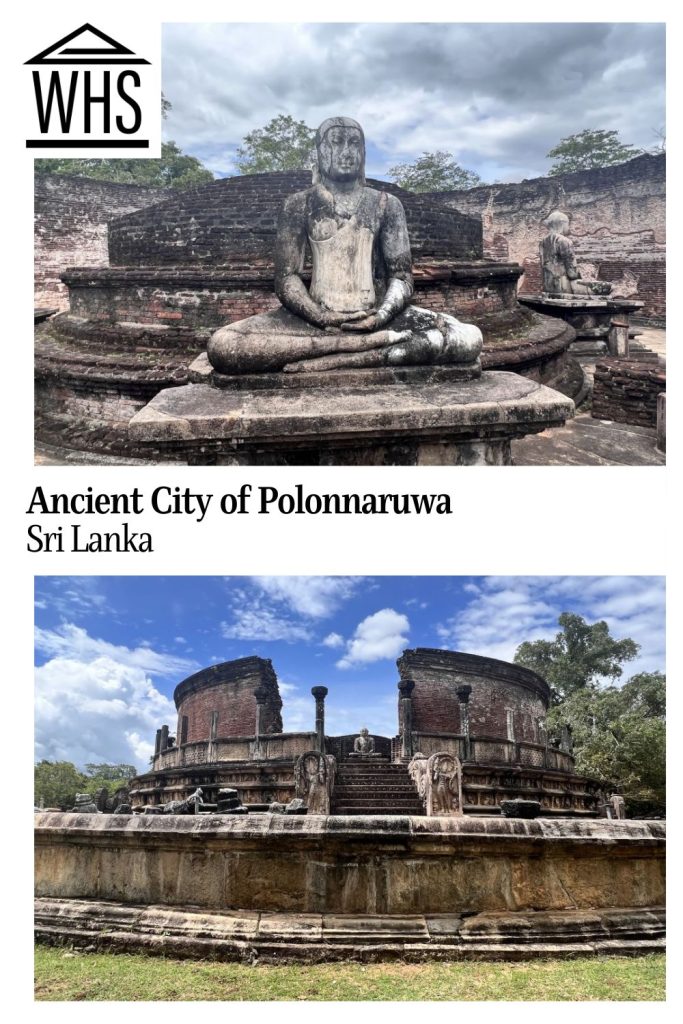
Disclosure: This article contains affiliate links. Making a purchase through an affiliate link will mean a small commission for this website. This will not affect your price. Privacy policy.
But the city’s glory was short-lived. It suffered numerous attacks and invasions throughout the 13th century, leading to its eventual abandonment. Nature reclaimed the city, and it was forgotten for centuries until extensive archaeological excavations in the 19th century brought this lost kingdom back to light.
Today, the archaeological site of Polonnaruwa extends over an impressive 122 hectares (300 acres). It’s part of Sri Lanka’s Cultural Triangle (along with Anuradhapura and Kandy) and stands as one of the country’s most important historical treasures, now proudly listed as a UNESCO World Heritage site.
Why is Polonnaruwa a UNESCO World Heritage site?
The Ancient City of Polonnaruwa earned its UNESCO status in 1982, primarily due to the incredible preservation of its historical buildings, some dating back to the 11th century, as well as the “special relationship of its buildings with the natural setting.” Walking among these ancient structures, it amazed me that after nearly a millennium, so much detail and architectural brilliance remains intact!
The site showcases outstanding examples of early urban planning, advanced hydraulic engineering (Those ancient water systems still function!), and remarkable Buddhist art and architecture. It is a testament to the Chola civilization as well as the Sinhalese rulers that followed them in the 12th and 13th century.
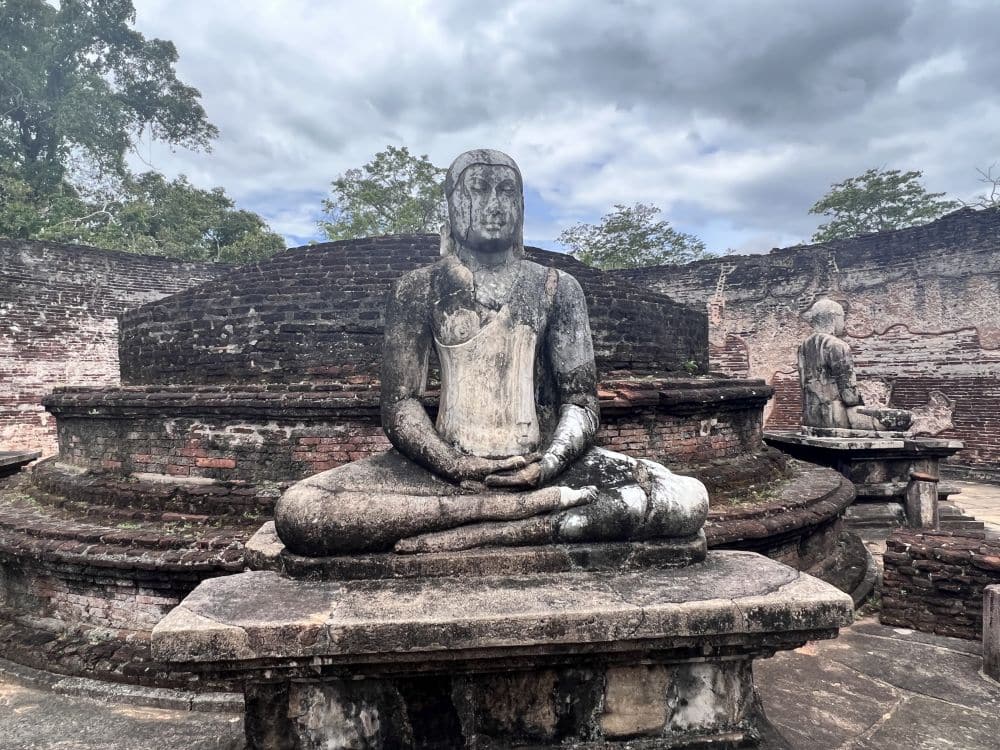
What can you expect on a visit to Polonnaruwa?
Prepare to be overwhelmed – in the best possible way! Polonnaruwa is huge. My first stop was the site museum near the entrance, which I highly recommend. It does a beautiful job showcasing the history of the ancient city and explaining the cultural significance of the buildings and the Buddhist religion. This context definitely enhanced my experience of the ruins themselves.
As you explore the vast archaeological park, you’ll encounter magnificent dagobas (dome-shaped Buddhist shrines), intricately carved temples, massive Buddha statues, royal palaces, and sophisticated bathing pools. The famous Gal Vihara with its enormous Buddha figures carved from a single granite wall is simply breathtaking!
The ancient irrigation systems demonstrate the advanced engineering skills of these ancient Sri Lankans. Standing at the edge of the enormous reservoir, I couldn’t help but marvel at what they accomplished without modern technology.
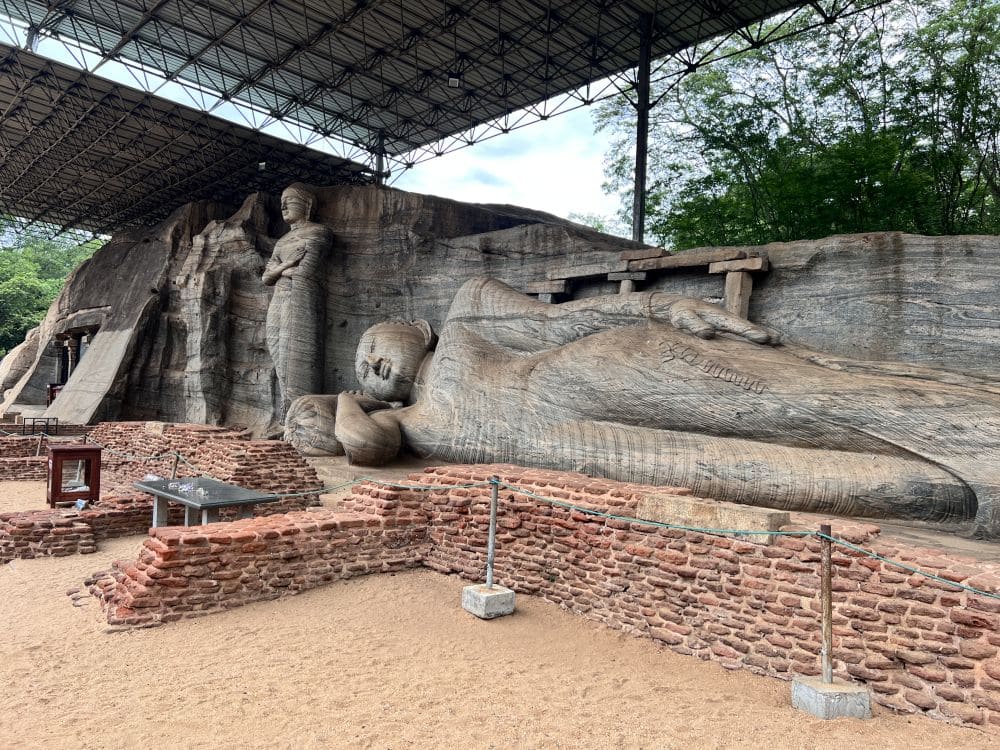
Is the Ancient City of Polonnaruwa worth visiting?
The site is spectacular and remarkably well-maintained. (Let’s be honest: that isn’t always the case in Sri Lanka!) The numerous ruins throughout the ancient city are well-preserved enough to give you a direct connection to ancient Sri Lanka.
I found some of the buildings absolutely incredible and visiting definitely helped deepen my understanding of Sri Lanka’s cultural heritage. That said, I should mention that as the site is enormous, it might become tedious if you’re not a history enthusiast. My husband found it a bit overwhelming and wouldn’t put it high on his list of top places to visit in Sri Lanka.
We also discovered it to be quite far from other major attractions on our itinerary, despite being part of the Cultural Triangle. We spent more time in the car making the detour to visit Polonnaruwa than we had anticipated. All things considered, I’d say if it’s already on your route, you should definitely stop and see it, but I wouldn’t call it the absolute must-see sight in Sri Lanka.
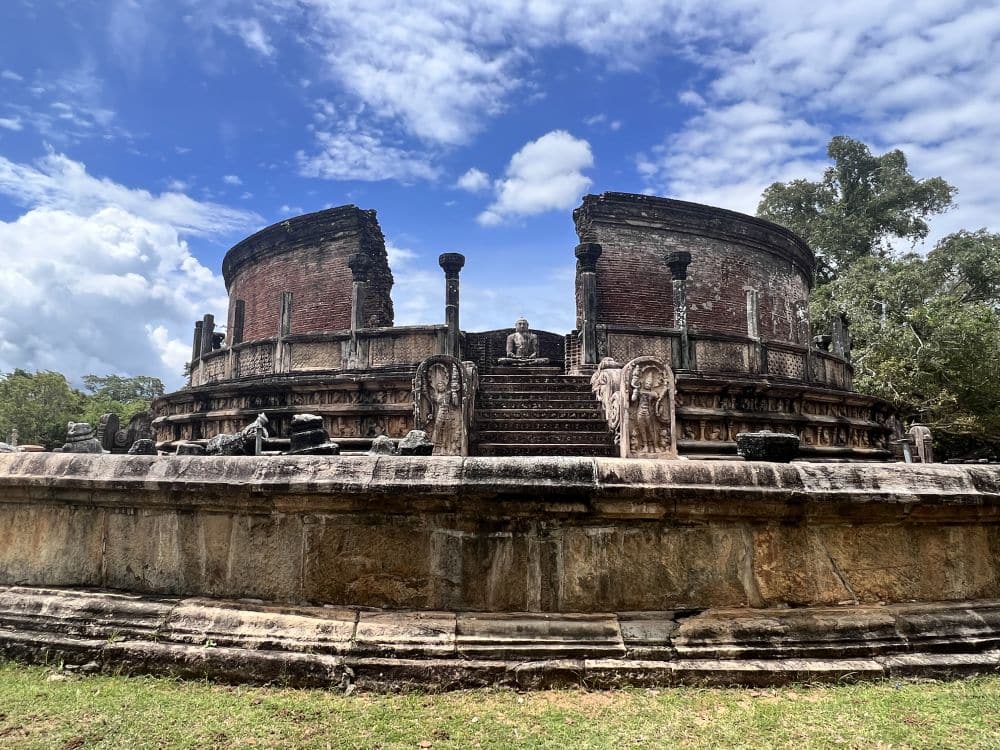
What sorts of travelers would like Polonnaruwa?
This place is paradise for archaeology lovers, history enthusiasts, and anyone who wants to truly understand Buddhist culture in Sri Lanka. The architectural achievements and detailed stone carvings will fascinate those interested in ancient civilizations.
I wouldn’t recommend Polonnaruwa for travelers who aren’t passionate about history, especially if you’re visiting during the hot season. The site requires significant walking or cycling in often sweltering heat. That can be exhausting if you’re not genuinely excited about what you’re seeing.
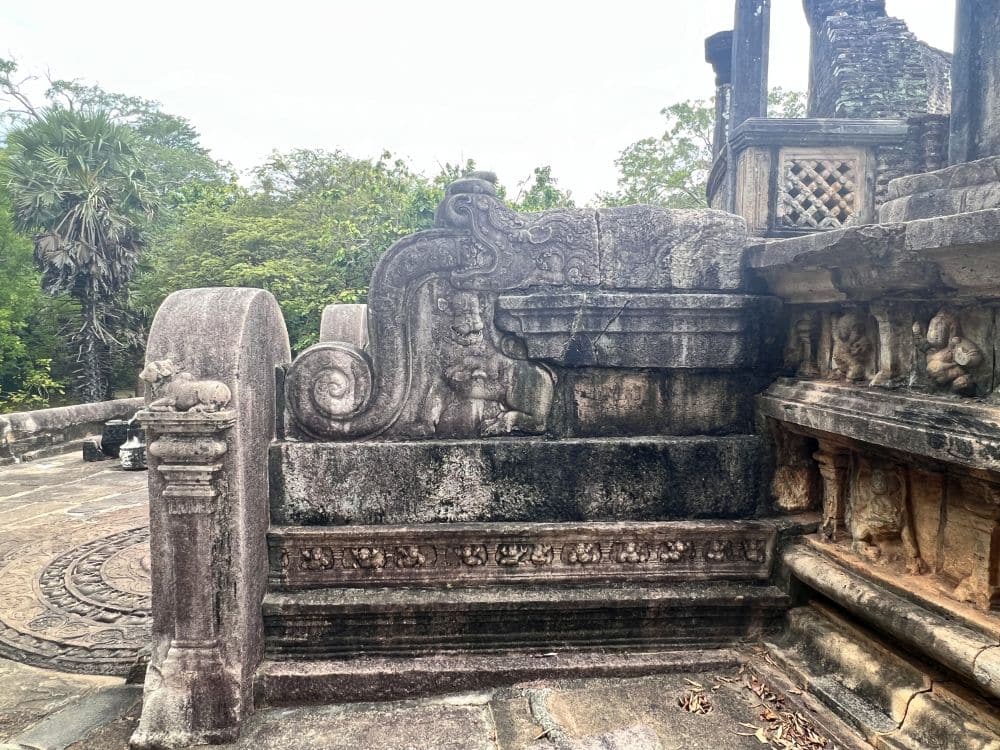
Tips for visiting Polonnaruwa
The Polonnaruwa site is massive. Exploring the entire complex on foot would take the better part of a day. While walking between monuments is technically doable, I definitely recommend renting bicycles (available on site) to cover the distances between the different structures. Trust me on this one – the heat and humidity can quickly drain your energy!
At the entrance (at the museum which is located on Habarana Rd), several guides will offer their services. This is common practice in Sri Lanka. We initially hesitated to hire a guide, especially since our driver (who was with us for the entire trip) said we wouldn’t need one. But being a history lover, I decided to accept a local guide’s services – and I’m so glad we did! He explained everything in detail, from the museum exhibits to the significance of each structure, and introduced us to Buddhism in a way that completely transformed our understanding of the site. There are some information signs at each monument, but reading them under the blazing sun doesn’t compare to having a knowledgeable person explaining things to you.
Since Polonnaruwa is primarily an archaeological site composed of ruins, you generally don’t need to cover your shoulders and legs. However, there are a few active temples within the complex, like Gal Vihara. My tip? Wear short sleeves rather than a sleeveless top, and bring a scarf or shawl in your backpack to tie around your waist when needed. This way, your legs are covered, and you can visit these essential parts of the site without any issues.
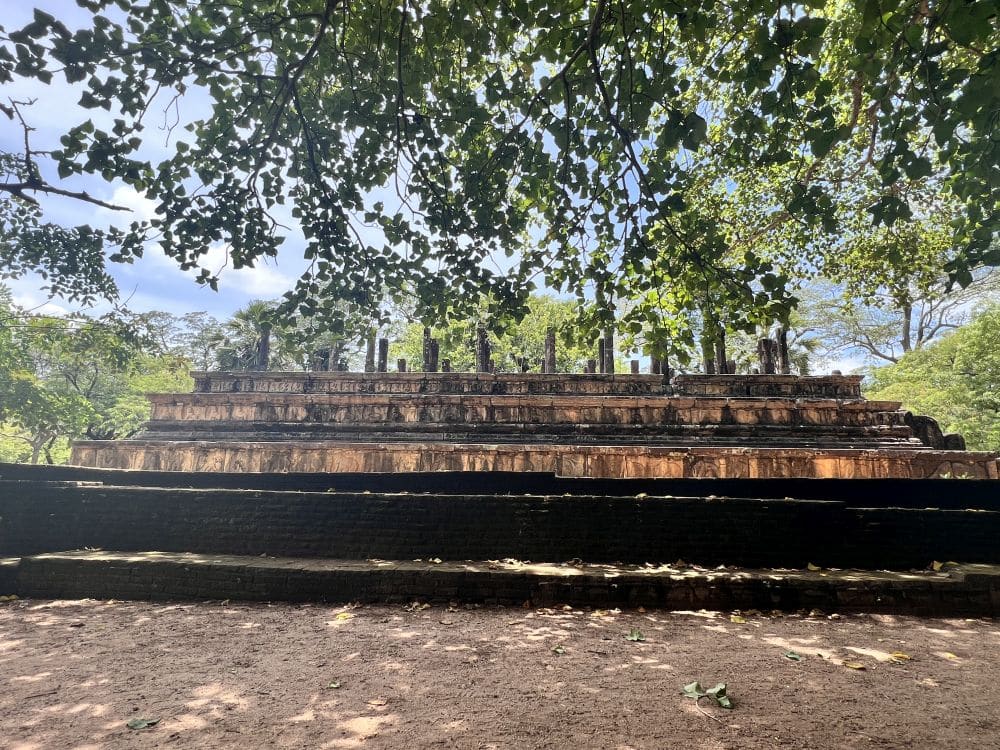
The tickets are valid for just one entrance, but if you want to leave the site to have lunch, for example, you can ask one of the guardians to sign your ticket so that you can come back in.
Other UNESCO sites not far away are the Rangiri Dambulla Cave Temple (really multiple caves) and the Ancient City of Sigiriya.
Most visitors opt for a private driver or join a tour group, which is what we did. Having transportation arranged was particularly valuable given Polonnaruwa’s distance from other major sites.
Day tours are available from Sigiriya or Kandy, or you can meet a tour in Polonnaruwa:
- Day trip from Sigiriya
- Day trip from Kandy
- Polonnaruwa private tour
- Private cycling tour of Polonnaruwa
Find accommodations in Polonnaruwa, Sigiriya, or Kandy.
Where is Polonnaruwa?
Polonnaruwa is located in Sri Lanka’s North Central Province, about 230 kilometers (143 miles) northeast of Colombo and about 140 kilometers (87 miles) northeast of Kandy.
By car from Colombo, the journey takes approximately 5-6 hours. From Kandy, expect a 3-4-hour drive. From Anuradhapura (another ancient capital and part of the Cultural Triangle), it’s about a 1.5-hour drive. There is parking available at the site entrance, which was free when we visited, though this might change.
Public transportation is possible but can be challenging. The entire journey could take 6 hours from Colombo or 3-4 hours from Kandy. Alternatively, you can take a train from Colombo to Polonnaruwa, though service is limited and the station is a few kilometers from the ancient city (at Kaduruwela). There are frequent busses from Kadaruwela to Polonnaruwa, or you can take a tuk-tuk for around 250 rs.
Have you been to the Ancient City of Polonnaruwa? If so, do you have any additional information or advice about this UNESCO World Heritage site? Please add your comments below!


